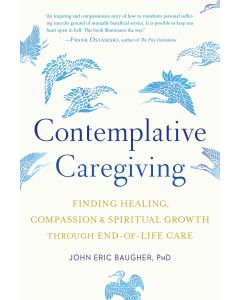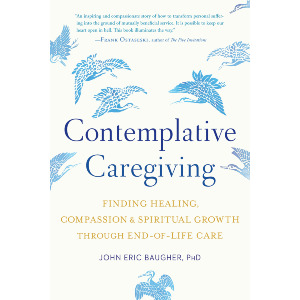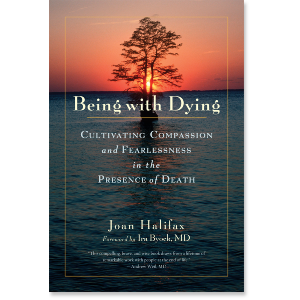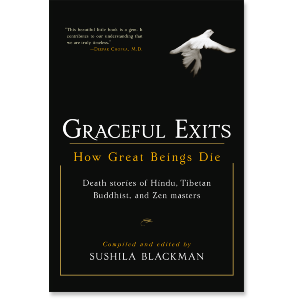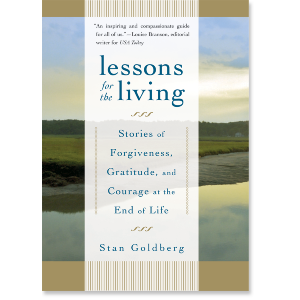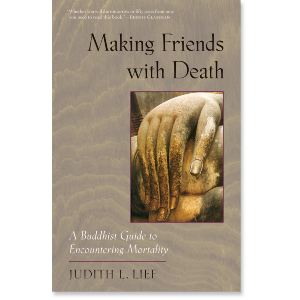

John Eric Baugher
John Eric Baugher, PhD, has been a contemplative educator, social science researcher, and end-of-life caregiver for more than two decades. He is the co-editor of Leading with Spirit, Presence, and Authenticity and Creative Social Change: Leadership for a Healthy World. Dr. Baugher consults and offers workshops internationally on spiritual care, grief and transformation, and contemplative learning. To learn more, please visit johnericbaugher.com.
John Eric Baugher
GUIDES
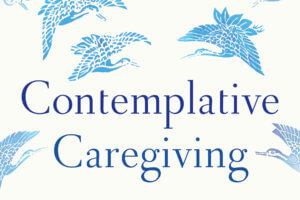
An excerpt from Contemplative Caregiving
“In the beginner’s mind there are many possibilities, but in the expert’s there are few.” This pithy teaching from Shunryu Suzuki’s Zen Mind, Beginner’s Mind offers a powerful reminder of the need for flexibility and receptivity in compassionate care.1 Many hospice caregivers will tell you that their patients have been their greatest teachers. Oftentimes encounters with one’s first patient stand out as particularly powerful teaching moments. On that day in 1993 when I first visited Jerome, he invited me to have lunch with him, so we went into his kitchen and prepared turkey and avocado sandwiches. “Look at that avocado smiling at me,” Jerome mused between bites. I looked over, and it was true. There it was, a joyful smile peeking out from between two slices of bread, there to be seen by all with eyes of wonder. And there I was, learning to see and enjoy the beauty of what I would have likely missed in another context—gratitude for the kindness of avocados.
I visited Jerome every week for the last three months of his life. On most of my visits, we were alone in his apartment. In the final weeks of his life, friends would come by to see him, and it seemed many of these visitors were quite anxious. Many young men were dying, and the community was gripped by grief and terror as it witnessed so many loved ones suffer this stigmatized death, not knowing whom it would take next. Jerome knew he was an object of fear. And I understood that the most essential care I could offer was to embody as best I could a nonanxious presence. For the most part, I felt calm when I was with him. As a straight man stepping into the gay community in this limited role as hospice caregiver, I didn’t have the same fears or depth of grief as Jerome’s other visitors. But one day I had my turn.
During one of my afternoon visits, a hospice aide came by to check in on Jerome and give him a shave. At this point, Jerome was spending most of his time in a hospice bed set up in the living room, and so the aide just inclined the head of the bed and got to work. She was quite efficient. She managed to shave Jerome without exchanging a word aside from the initial hello and explanation of who she was and what she came to do. Sitting in the chair in front of the bed, I just watched quietly while she lathered Jerome’s face and took care of business. After she left, Jerome and I picked up our conversation where we had left off. And then he asked if I would massage his shoulders. He indicated that there was some lotion in the drawer of the end table at the head of the bed, so I walked around behind him, opened the drawer, and took out the lotion. And then I saw it just sitting there on the top of the table—the box of disposable gloves.
In all the weeks I had been visiting Jerome, it had never crossed my mind to put on gloves. But there they were. The hospice aide had brought them, and I saw her put on a pair before shaving Jerome. So I assumed I should as well. I reached into the box and grabbed a pair. Jerome heard me putting on the first glove, and in a despondent voice he said, “You don’t have to put those on.” I stood there for a moment, unsure of what to do. And then I got scared. Jerome couldn’t see my face, but I winced in embarrassment as I put on the other glove. I couldn’t speak. I slowly put a dab of lotion on my gloved fingers and began massaging his shoulders. Jerome hung his head under the weight of my touch. I did as well, as I witnessed how my own fear and discomfort had placed a barrier between us.
Mindfulness isn’t some magic state where we no longer feel fear, anxiety, or other uncomfortable emotions. It’s about seeing with clarity what’s going on inside us and around us and being able to respond in a manner consistent with our intentions.
Recently I completed a training program to become licensed as a certified nursing assistant (CNA). Early in the course, the instructor, a registered nurse, spoke of what she called “overgloving,” the tendency among some nursing staff to wear gloves for any kind of patient contact. She asked students in the course, “How many of you have ever gotten a massage? Did the massage therapist wear gloves? How many of you have ever gotten your haircut? Did the person wear gloves?” The training program focused on the competencies and skills needed by CNAs to assist with the many tasks of basic nursing care, yet the instructor reminded us that human touch, more than anything else, is the most essential dimension of our work. “How unfortunate it would be,” she continued, “if you went through the day checking vital signs without ever actually touching a human hand.” She suggested how healing it can be for patients to receive a five-minute back rub in between all the medical contact, and then, as if speaking directly to me, she offered, “But sometimes it might be better to not give a massage than to give a massage with gloves on.”
It was wise practice for the aide to wear gloves while shaving Jerome. But it would have been better for me not to massage Jerome that day than to do so as I did. My touch, in silence, was harmful for Jerome, feeding into the stigma that people with HIV/AIDS are untouchable. The problem wasn’t that I wore gloves when I didn’t need to, but that I couldn’t relate directly to my own fear. Mindfulness isn’t some magic state where we no longer feel fear, anxiety, or other uncomfortable emotions. It’s about seeing with clarity what’s going on inside us and around us and being able to respond in a manner consistent with our intentions.
My intention was to be a loving presence in Jerome’s life for those few hours each week that we were together. But my compassion was limited by dualistic thinking. Jerome knew I didn’t need to wear the gloves to massage his intact skin. My rational mind knew that as well, but I was too terrified not to. With beginner’s mind, there would have been other possibilities that honored both my fear and Jerome’s need for human touch. The essence of beginner’s mind is the nondualistic flexibility to see such compassionate possibilities. How might my touch have felt, gloves and all, had I paused in mindfulness for a moment, come around to the front of Jerome’s bed, and owned my fear rather than shrouding it in oppressive silence?
Releasing Expectations
"Hospitality is not about what you do, it is about who you are becoming."
—Father Daniel Homan and Lonni Collins Pratt, Radical Hospitality
The dominant conception of a good death in the mainstream hospice movement includes dying people sharing deep feelings and engaging in life review. Allowing space for patients and their family members to talk about their experiences can support healing, yet some individuals come to hospice work with romanticized notions of what it will be like to listen to dying people reflect on their lives or to help family members work through the grief of losing a loved one. In many instances, the practice of mindfulness as a caregiver means letting go of such romantic expectations and simply being present to the situation as it is.
Many volunteers I interviewed indicated that they had to release their expectations of what it would be like to care for hospice patients, given the actual needs of those they encountered in the course of their work. Diane had been assigned to hospice patients at a nursing home in upstate New York. I interviewed her two years after she had completed the volunteer training, and then we spoke again five years later. By that time, she had stopped volunteering for hospice to care for one of her closest friends who had been diagnosed with colon cancer. At age sixty-six, she reflected back on her five years as a hospice volunteer. “I definitely was drawn into volunteering in part because I thought that life review was really important as a part of readying for dying,” she said. “But,” she continued, “one of the things I learned right away in nursing home contacts was that this didn’t necessarily become my job, and in fact, was rarely my role. I did love hearing stories from patients, but probably half of the patients I met were quiet and may or may not have been aware [that I was there].” Listening in this context “involved being a lot more present and flexible about expectations.” Diane expressed a deep reverence for the many people she encountered through her hospice work, including those who were unable to speak. “[I never] felt that the talking and friendly nature of some relationships was any better or more important than the time I spent next to a sleeping patient,” she emphasized.
Amy, age forty-nine, volunteered at the same hospice in upstate New York. She and I had gone through the volunteer training session together about a year before I interviewed her, and she referenced a line directly out of our training manual: in order to do this work, “you have to have really big ears.” She clarified, however, that for her, listening did not necessarily imply having a conversation. Instead, you listen “not just for the auditory things, you listen visually, you listen subliminally, and that openness I think is very important.” She originally signed up for hospice with the intention to do home visits, but she ended up visiting patients in the hospital two mornings each week because that was where the volunteer coordinator indicated was the greatest need. Amy was assigned to patients in two hospitals, and in her first eleven months as a volunteer, she accompanied over one hundred individuals in the final days of their lives. She approached these encounters with openness and reverence: “I love the spirits of the people that I see and meet, no matter what state they’re in.”
The practice of mindfulness as a caregiver means letting go of such romantic expectations and simply being present to the situation as it is.
Quite often volunteers find deep meaning in listening to the fears or life stories of dying people and their family members, yet, as Diane and Amy quickly discovered, at the very end many individuals simply do not have the energy to carry on conversations. And even when they are able, some patients or family members may not wish to talk about their experiences, and instead may request that volunteers run errands, watch TV, or do other mundane things. Tonya, a retired nurse, had been volunteering for hospice for eleven years, and two of those years were spent caring for a patient who confronted her with the limitations of her own preconceived notion of what a “peaceful death” should look like. Whereas Tonya had expected that they might occasionally engage in “quiet conversation,” she described how the patient “didn’t want to stop and even recognize the fact that she was dying, that her body was slowing down.” At the time, Tonya thought that the woman was just “running from death.” She found being in her presence “unsettling because it wasn’t peaceful.”
She wanted me to push her in her wheelchair to a meeting, push her here, push her to the aqua festival, push her to, you know, she wanted to go to the fairgrounds. Mind you now, she’s probably fifty-something pounds and can’t stand up on her own, and she wanted me to take her to the health food store, because she was going to eat right, you know. And it was just like, I wanted to be a little more realistic about things. I mean that’s me putting my values on things and I would get a little frustrated with myself, in spite of the fact that I know I was being judgmental and not just assisting her. I mean I had to deal with me.
Caring for this woman over a period of two years repeatedly held up a mirror for Tonya to investigate why the experience made her uneasy, with a sense that she wasn’t doing it right. In hindsight, she laughed about her journey with this woman, who just kept going and going, and then died in a way that reflected the preferences she had been expressing all along: “She went to a meeting, . . . laid down for a nap, and died.” Tonya had experienced this woman as “demanding and controlling,” yet in the end, she explained, “I had to deal with me.” The caregiving experience came with a dawning realization: “I’m not as nice as I’d like to be.” Despite her view that this woman was a “control freak about [dying], instead of just going with the flow,” in the course of time, Tonya came to see that it was her own attempt to control how this woman lived her final months of life that was the source of her frustration.
Kerstin likewise explained that her understanding of what it means to accompany a patient had changed considerably over the course of her three years as a hospice volunteer. In her experience, what is most essential to accompanying others at the end of life is “leaving your expectations at the door.” She came to the insight that “you never know upfront what your role really is. . . . It’s not always so clear who actually wants me to be there. . . . It’s more often the case that it’s not the patient at all but the family who need support, so at first you really have to check things out and ask yourself, ‘Who am I primarily here for?’” She laughed and added, “You show up, but maybe someone doesn’t want you there at all. So again and again you have to find out what your place really is.” Several volunteers spoke about the suffering of family members being even greater than that of the patient, a dynamic I have also witnessed on many occasions in my work as a hospice volunteer.
But the biggest change Kerstin described concerned her expectations about listening and spirituality. “When I started out, the spiritual component was for me personally the most important aspect, and I simply thought that when someone comes to the end of their life that they would automatically have the need to come to terms with the meaning of their life, to engage in life review, and perhaps also be engaged with spiritual questions like, ‘What comes next?’ ‘Is this really the end, or does life continue?’ ‘Is death just a transition?’”
She had a good laugh at herself regarding the assumptions she had about the needs of dying people. Experience had taught her that “for many patients, what really matters are quite practical issues, just being there, offering support, but not necessarily regarding spiritual matters.” She admitted that sometimes she felt a sense of disappointment that it was not possible to talk to this or that patient about deeper questions of meaning, but “that is my issue, and that has nothing to do with the patients I am caring for.”
Witnessing Emotional Reactions and Judgments
Giving good care as a hospice volunteer does not require that one do anything in particular, such as engaging patients in life review or getting them to talk about their feelings. Instead, it requires that the caregiver herself becomes more flexible, open, and receptive to the actual needs of the other, beyond preconceived notions of good and bad, proper and improper, right and wrong. This insight ties in with a central principle of hospice care: what matters most are the wishes of hospice patients and their family members, and no matter what comes, volunteers and staff should not pass judgment on those entrusted to their care. In the everyday talk of hospice volunteering, this principle is referred to as “listening without judgment,” and it is seen as central to the quality of care volunteers offer. But it would be naïve to think that one can simply decide once and for all not to have judgments. What happens when volunteers feel irritation and a sense of judgment at the hospice bedside? How do hospice caregivers work with such discomfort?
One possibility is that one may feel a sense of judgment but not express it to patients or their family members. Sociologist Arlie Hochschild calls this process “emotion work,” managing one’s emotions according to the implicit “feeling rules” that direct how one is supposed to feel and act in a given situation.2 In some contexts, it may be skillful for volunteers to control their display of verbal and nonverbal behaviors to avoid potentially harming the patient or family member. At a training session at a hospice in Virginia, for example, a story came up about a family that arranged a viewing of their baby in which the dead baby was displayed sitting up in her playpen surrounded by her toys. The imagined scene elicited “a communal gasp of horror” among the trainees, but the hospice director quickly interjected, “If your patient’s family expresses a similar wish, you cannot gasp. Your jaw cannot drop open. You are there to help, not to impose your own tastes and preferences on them.”3
Caring for dying people gives hospice volunteers the opportunity to practice seeing that things are not always as they appear, or that what at first appears is not all there is. “I don’t judge everything according to appearances. Appearances aren’t everything,” explained Frau Schneider. She had volunteered for hospice in Freiburg, Germany, for over nine years, and she indicated that a benefit of her long-term engagement in hospice was that it had allowed her to gain this “wisdom.” Rather than jumping to conclusions, through her experiences with hospice, she has developed the habit of pausing and asking herself, “My God, what is this person really going through at the moment?”
What matters most are the wishes of hospice patients and their family members, and no matter what comes, volunteers and staff should not pass judgment on those entrusted to their care.
Similarly, Zemira explained how end-of-life care challenges caregivers to practice taking a broader perspective than they normally take in everyday life. She had recently had a patient whom she described as a “really prickly” woman, and her initial reaction was “Ugh, I don’t like this person.” But then she stopped herself and became interested in why she had this reaction, “and so I watched myself doing that, and changing, watching my feelings and how I was reacting to that.” She continued, “This was not a woman who had a particular style that I like, she wasn’t a warm fuzzy. I like warm fuzzies, warm fuzzies are great for me, I do very well with that, and she was not.” But rather than reacting blindly to her aversion or simply trying to stuff down her feelings, she explained how volunteering for hospice opened in her a curiosity to understand “what might be behind” the woman’s hard exterior, which she said was “a new question” for her. “I think most of the time we see someone we don’t like, we say, ‘Ugh, we don’t like them,’ and that’s the challenge to say, ‘What really is going on here?’ And ‘Why maybe is this person doing this?’”
Manuel described a situation in the nursing home where he witnessed family members arguing with each other in the presence of the patient. He acknowledged that he felt “a small grain” of judgment toward the family, because he could see that the turmoil in the room was upsetting the patient. Yet he kept his thoughts to himself, stating, “It’s not my place to say anything. I can’t say anything. Even if I felt it, even if I had a reaction where I could say, ‘Why are you arguing over the patient? Can’t you see he’s getting upset hearing you argue?’ I really can’t say anything, because it’s none of my business.” Referring to the distinction between having a thought and expressing one’s views, he continued, “Can I have an opinion? Yeah. Can I be judgmental? No.”
Here Manuel was not simply submitting his feelings to social norms, but instead, his decision to witness quietly this family dynamic in the face of his own discomfort was grounded in a more spacious view: “You don’t really know their situation.” Manuel’s humility and generosity of interpretation with this struggling family was linked to his own family’s recent experience of doing their best to care for his mother, who died on that same Alzheimer’s wing of the nursing home. In this way, his quiet witness in this situation was an act of compassion not only for those struggling family members but also for himself—for the dedicated yet imperfect care he had offered his own mother.
Loving Our Imperfect Care
I invite you to think of a time when you were not at your best as a caregiver. Perhaps a particular encounter comes to mind in rich detail, or maybe the specifics have faded but what remains is a sense of guilt, embarrassment, or shame for what you did or did not do as a caregiver. If more than one memory comes to mind, that is fine, but eventually choose one particular experience for this practice. If quite painful experiences come to mind, you might begin this exercise with less painful memories as a way of trying out the process. In any case, trust your own sense of what is best for you in this moment.
There are three parts to this contemplation. First, begin by describing in detail precisely what took place. You may find it helpful to write down those details or speak them to a partner who listens as a silent witness. Whatever approach you take, imagine that a video was taken of what took place, and based on your memory, simply describe what one would see on that video. In other words, describe the scene from the perspective of an outside observer. Perhaps it was a time when you fought or argued with other members of the family in front of someone who was sick or dying. Just describe the scene as it appears without prior interpretation.
Second, after you have written down or told someone the details that would be captured on the video, imagine what kinds of judgments someone might make about the person they saw in the video. We are often our harshest critic, so perhaps you don’t have to imagine judgments one might have but instead it may be judgments you have actually felt about yourself based on the memory. If that is the case, try not to evoke the intensity of the feeling but instead express those judgments in the third person. For example, “This person is being disrespectful by arguing in front of the patient,” or “This person is being controlling by trying to force food onto someone who no longer wishes to eat.”
The third part of this contemplation involves taking the stance of a compassionate witness. Rarely do we care under the best conditions, so for this part, describe the wider context that shaped what took place in that video. Perhaps you were exhausted beyond words, pressed for time, worried about finances, feeling stuck in old relational patterns, or grieving losses you could not yet fully imagine. And perhaps none of these dynamics would be apparent to an outside observer watching that video. All he would see is our short temper, our prickliness, our irritability. There is always more than meets the eye, so describe with the energy of a loving friend what that person in the video was going through at that time. If necessary, stretch yourself to truly feel compassion for the caregiver in that video.
INTEGRATION
Notes
- Shunryu Suzuki, Zen Mind, Beginner’s Mind (Boston: Shambhala Publications, 2011), 2.
- Arlie Russell Hochschild, The Managed Heart: Commercialization of Human Feeling (Berkeley: University of California Press, 1983).
- Christine Andreae, When Evening Comes: The Education of a Hospice Volunteer (New York: St. Martin’s Press, 2000), 5.
Share
Related Books

John Eric Baugher, PhD, has been a contemplative educator, social science researcher, and end-of-life caregiver for more than two decades. He is the co-editor of Leading with Spirit, Presence, and Authenticity and Creative Social Change: Leadership for a Healthy World. Learn more.

